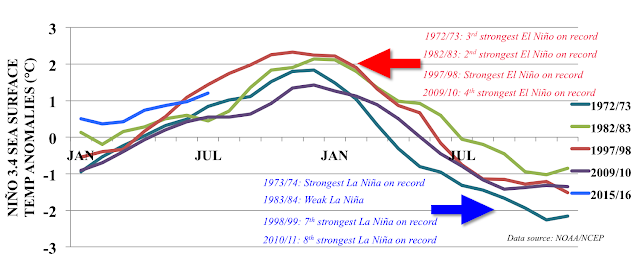by Karen Braun, Senior Analyst at Thompson Reuters
First published in Milling and Grain, September 2015
Now that massive El Niño is all but locked in for late 2015 into early 2016, what comes next? The current prediction range of international climate models only extends to mid 2016, but fancy technology is not required to identify compelling patterns.
In isolating the strongest four El Niño events on record since 1950, these years were followed by the first, seventh, and eighth strongest La Niña events on record. The fourth year was classified as borderline/weak La Niña. If history repeats itself, the Northern Hemispheric winter of 2016/17 is likely to feature at least weak La Niña conditions.
From an agriculture perspective, one of the biggest shake-ups that could result from a return to La Niña in 2016 is in the soybean market. La Niña is more likely to present drought-like conditions during the summer growing seasons in the United States, southern Brazil, and Argentina, where almost all of the world's soybean exports originate.
To add even more interest to the mix, if La Niña occurs in 2016/17, winter 2017/18 is likely to follow suit. Two-thirds of past La Niña events were followed by another year of La Niña or La Niña-like conditions. Further, strong La Niña events are four times as likely to occur in consecutive years than strong El Niño events.
So if La Niña were to truly persist from late 2016 through at least mid 2018, the recently bearish times for soybeans may come to an end as world soybean supply could take a massive hit. Of course this is assuming that the La Niña sticks around for a couple years. And that it produces the expected effects on the Americas. And that it even shows up in the first place.
Read the magazine HERE.
First published in Milling and Grain, September 2015
Now that massive El Niño is all but locked in for late 2015 into early 2016, what comes next? The current prediction range of international climate models only extends to mid 2016, but fancy technology is not required to identify compelling patterns.
In isolating the strongest four El Niño events on record since 1950, these years were followed by the first, seventh, and eighth strongest La Niña events on record. The fourth year was classified as borderline/weak La Niña. If history repeats itself, the Northern Hemispheric winter of 2016/17 is likely to feature at least weak La Niña conditions.
From an agriculture perspective, one of the biggest shake-ups that could result from a return to La Niña in 2016 is in the soybean market. La Niña is more likely to present drought-like conditions during the summer growing seasons in the United States, southern Brazil, and Argentina, where almost all of the world's soybean exports originate.
To add even more interest to the mix, if La Niña occurs in 2016/17, winter 2017/18 is likely to follow suit. Two-thirds of past La Niña events were followed by another year of La Niña or La Niña-like conditions. Further, strong La Niña events are four times as likely to occur in consecutive years than strong El Niño events.
So if La Niña were to truly persist from late 2016 through at least mid 2018, the recently bearish times for soybeans may come to an end as world soybean supply could take a massive hit. Of course this is assuming that the La Niña sticks around for a couple years. And that it produces the expected effects on the Americas. And that it even shows up in the first place.
Read the magazine HERE.
The Global Miller
This blog is maintained by The Global Miller staff and is supported by the magazine GFMT
which is published by Perendale Publishers Limited.
For additional daily news from milling around the world: global-milling.com



No comments:
Post a Comment